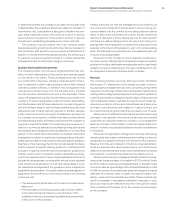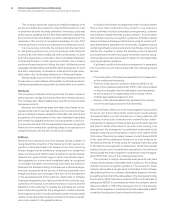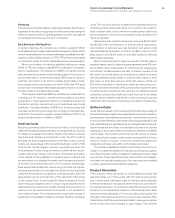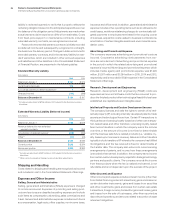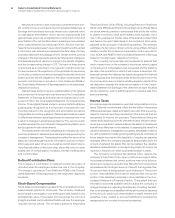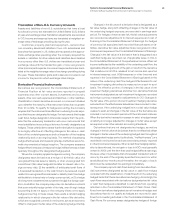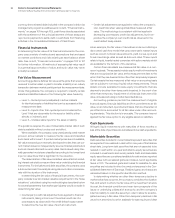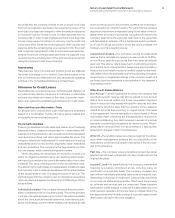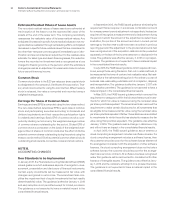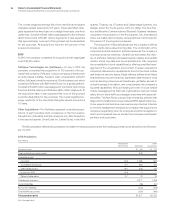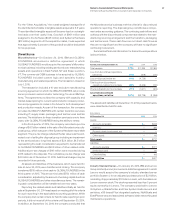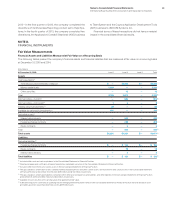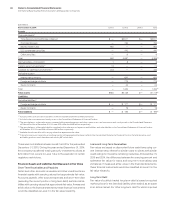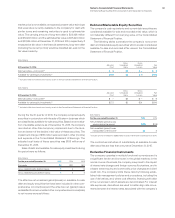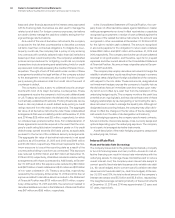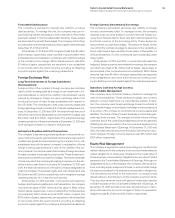IBM 2015 Annual Report Download - page 95
Download and view the complete annual report
Please find page 95 of the 2015 IBM annual report below. You can navigate through the pages in the report by either clicking on the pages listed below, or by using the keyword search tool below to find specific information within the annual report.Notes to Consolidated Financial Statements
International Business Machines Corporation and Subsidiary Companies
93
In May 2014, the FASB issued guidance on the recognition of
revenue from contracts with customers. Revenue recognition will
depict the transfer of promised goods or services to customers
in an amount that reflects the consideration to which the entity
expects to be entitled in exchange for those goods or services. The
guidance also requires disclosures regarding the nature, amount,
timing and uncertainty of revenue and cash flows arising from
contracts with customers. The guidance permits two methods of
adoption: retrospectively to each prior reporting period presented,
or retrospectively with the cumulative effect of initially applying the
guidance recognized at the date of initial application (the cumula-
tive catch-up transition method). The guidance was initially effective
January1, 2017 and early adoption was not permitted. In August
2015, the FASB issued guidance which provides for a one-year
deferral of the effective date to January1, 2018, with an option of
applying the standard on the original effective date. The company
will adopt the guidance on January1, 2018 and apply the cumulative
catch-up transition method. The company is continuing to evaluate
the impact of the new guidance in the consolidated financial results.
Standards Implemented
In November 2015, the FASB issued guidance which requires
deferred tax liabilities and assets be classified as noncurrent in
the statement of financial position. The guidance was effective
January1, 2016 with early adoption permitted. The company
adopted the guidance in the fourth quarter of 2015 on a retro-
spective basis. The company reclassified current deferred tax
assets of $2.0billion at December31, 2014 to deferred tax assets
and current deferred tax liabilities of $19million at December31,
2014 to other liabilities from other accrued expenses and liabilities
in the Consolidated Statement of Financial Position. In order to
offset deferred tax assets and liabilities for presentation as a single
noncurrent amount by tax jurisdiction, the company also reclassi-
fied $178million at December31, 2014 from deferred tax assets to
other liabilities in the Consolidated Statement of Financial Position.
In April 2015, the FASB issued guidance which requires debt
issuance costs related to a recognized debt liability to be presented
in the balance sheet as a direct deduction from the carrying amount
of that debt liability, consistent with debt discounts. The guidance
was effective January1, 2016 with early adoption permitted. The
company adopted the guidance in the fourth quarter of 2015 on a
retrospective basis. At December31, 2015 and 2014, the company
had $74million and $83million, respectively, in debt issuance costs.
Debt issuance costs were previously included in investments and
sundry assets in the Consolidated Statement of Financial Position.
In April 2014, the FASB issued guidance that changed the cri-
teria for reporting a discontinued operation. Only disposals of a
component that represents a strategic shift that has (or will have)
a major effect on an entity’s operations and financial results is
a discontinued operation. The guidance also requires expanded
disclosures about discontinued operations and disposals of a
significant part of an entity that does not qualify for discontinued
operations reporting. The guidance was effective January1, 2015.
The impact to the company will be dependent on any transaction
that is within the scope of the new guidance. There were no such
transactions in 2015.
In July 2013, the FASB issued guidance regarding the presen-
tation of an unrecognized tax benefit when a net operating loss
carryforward, a similar tax loss, or a tax credit carryforward exists.
Under certain circumstances, unrecognized tax benefits should be
presented in the financial statements as a reduction to a deferred
tax asset for a net operating loss carryforward, a similar tax loss,
or a tax credit carryforward. The guidance was effective January1,
2014. The guidance was a change in financial statement presen-
tation only and did not have a material impact in the consolidated
financial results.
In March 2013, the FASB issued guidance on when foreign cur-
rency translation adjustments should be released to net income.
When a parent entity ceases to have a controlling financial interest
in a subsidiary or group of assets that is a business within a for-
eign entity, the parent is required to release any related cumulative
translation adjustment into net income. Accordingly, the cumula-
tive translation adjustment should be released into net income
only if the sale or transfer results in the complete or substantially
complete liquidation of the foreign entity in which the subsidiary
or group of assets had resided. The guidance was effective Janu-
ary1, 2014 and did not have a material impact in the consolidated
financial results.
In February 2013, the FASB issued guidance for the recognition,
measurement and disclosure of obligations resulting from joint
and several liability arrangements for which the total amount of the
obligation within the scope of the guidance is fixed at the report-
ing date. Examples include debt arrangements, other contractual
obligations and settled litigation matters. The guidance requires an
entity to measure such obligations as the sum of the amount that
the reporting entity agreed to pay on the basis of its arrangement
among its co-obligors plus additional amounts the reporting entity
expects to pay on behalf of its co-obligors. The guidance was
effective January1, 2014 and did not have a material impact in the
consolidated financial results.
NOTEC.
ACQUISITIONS/DIVESTITURES
Acquisitions
Purchase price consideration for all acquisitions, as reflected in
the tables in this note, is paid primarily in cash. All acquisitions
are reported in the Consolidated Statement of Cash Flows net of
acquired cash and cash equivalents.
2015
In 2015, the company completed fourteen acquisitions at an aggre-
gate cost of $3,555 million.
Merge Healthcare, Inc. (Merge)—On October13, 2015, the com-
pany completed the acquisition of 100percent of Merge, a publicly
held company, for cash consideration of $1,036 million. Merge is
a leading provider of medical image handling and processing,
interoperability and clinical systems designed to advance health-
care quality and efficiency. Merge joined the company’s Watson
Health business unit, bolstering clients’ ability to analyze and


